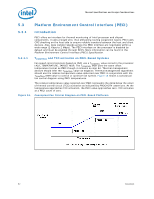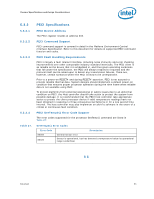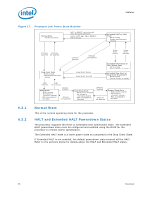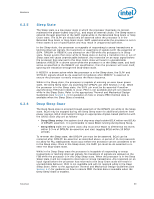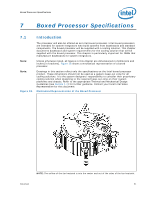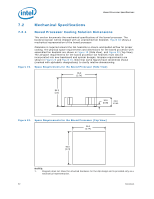Intel E3300 Data Sheet - Page 87
Stop Grant and Extended Stop Grant States
 |
View all Intel E3300 manuals
Add to My Manuals
Save this manual to your list of manuals |
Page 87 highlights
Features 6.2.2.1 6.2.2.2 6.2.3 6.2.3.1 HALT Powerdown State HALT is a low power state entered when all the processor cores have executed the HALT or MWAIT instructions. When one of the processor cores executes the HALT instruction, that processor core is halted, however, the other processor continues normal operation. The halted core will transition to the Normal state upon the occurrence of SMI#, INIT#, or LINT[1:0] (NMI, INTR). RESET# will cause the processor to immediately initialize itself. The return from a System Management Interrupt (SMI) handler can be to either Normal Mode or the HALT powerdown state. See the Intel Architecture Software Developer's Manual, Volume 3B: System Programming Guide, Part 2 for more information. The system can generate a STPCLK# while the processor is in the HALT powerdown state. When the system de-asserts the STPCLK# interrupt, the processor will return execution to the HALT state. While in HALT powerdown state, the processor will process bus snoops. Extended HALT Powerdown State Extended HALT is a low power state entered when all processor cores have executed the HALT or MWAIT instructions and Extended HALT has been enabled using the BIOS. When one of the processor cores executes the HALT instruction, that logical processor is halted; however, the other processor continues normal operation. The Extended HALT powerdown state must be enabled using the BIOS for the processor to remain within its specification. The processor will automatically transition to a lower frequency and voltage operating point before entering the Extended HALT state. Note that the processor FSB frequency is not altered; only the internal core frequency is changed. When entering the low power state, the processor will first switch to the lower bus ratio and then transition to the lower VID. While in Extended HALT state, the processor will process bus snoops. The processor exits the Extended HALT state when a break event occurs. When the processor exits the Extended HALT state, it will resume operation at the lower frequency, transition the VID to the original value, and then change the bus ratio back to the original value. Stop Grant and Extended Stop Grant States The processor supports the Stop Grant and Extended Stop Grant states. The Extended Stop Grant state is a feature that must be configured and enabled using the BIOS. Refer to the sections below for details about the Stop Grant and Extended Stop Grant states. Stop-Grant State When the STPCLK# signal is asserted, the Stop Grant state of the processor is entered 20 bus clocks after the response phase of the processor-issued Stop Grant Acknowledge special bus cycle. Since the GTL+ signals receive power from the FSB, these signals should not be driven (allowing the level to return to VTT) for minimum power drawn by the termination resistors in this state. In addition, all other input signals on the FSB should be driven to the inactive state. Datasheet 87



